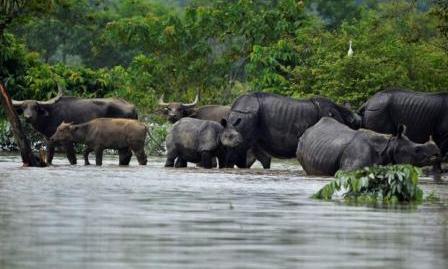The current wave of floods in Assam has claimed the lives of 187 animals in Kaziranga National Park (KNP) including 15 one horned rhinos, one elephants and over hundred hog deer, according to local news reports. Flood waters entered the Kaziranga National Park on July 13 and submerged almost 90 per cent of the park, forcing many of the wild animals to stray out of it.
However, many experts agree that animal lovers shouldn’t be focused on animals drowned by flood waters, but on how to protect the majority of animals forced to leave the relatively protected environment of KNP.

A senior official of the Assam forest department on Monday said that while a total of 15 one horned rhinos have been drowned; one elephant and over 103 hog deer have also reported to have died due to drowning during the current wave of flooding in the state.
The flood waters have also submerged the anti-poaching camps over the last one week.
Giving the details of the animals died during the floods, the senior park official said that a total of 13 wild boar, 12 sambar, six swamp deer, two water buffaloes and 3 porcupines have also died due to drowning.
Apart from this, he said, 16 animals including 15 hog deer and one sambar were killed by speeding vehicles on the National Highway 37.
He said that the forest officials and local villagers have also rescued 53 hog deer, some of which were later released in the wild again.
“Truth is, floods play an important role in maintaining key ecosystem functions and biodiversity. They link the river with the land surrounding it, recharge groundwater systems, fill wetlands, increase the connectivity between aquatic habitats, and move both sediment and nutrients around the landscape. For many species, floods trigger breeding events, migration, and dispersal. These natural systems are resilient to the effects of floods. Apart from the environmental benefits, flooding also helps the economy through increased agricultural and fish production, recharge of groundwater resources, to mention a few,” writes journalist Rahul Dutta, in a no-nonsense manner.
Dutta, and other observers point out that the most causalities are not caused by flood, but by humans who aren’t ‘flood friendly’
“Whether it is the Swamp Deer, Hog Deer, Elephants, Rhinos or the several hundred birds that call Kaziranga home, all have known how to deal with the floods from time immemorial. For the animals, floods aren’t the real problem; the problem is us, who have made the flood plains our home,” he says
Local people and environmental experts agree that many animals are not killed by nature but by the opportunistic killing of those who come across these stranded migrating animals, mainly for their meat.
Then there are casualties that take place on the highway that passes alongside Kaziranga. Many animals die in collisions with speeding vehicles. During the floods, though, the numbers are much higher as the animals attempt to reach the hills of Karbi Anglong by crossing the highway. Organized gangs of wildlife criminals are waiting in the shadows to make a killing out of such high value animals, says Dutta.
During the floods, Kaziranga authorities try their hardest to reduce animal-human conflict situations. A number of non-government organisations and individuals wholeheartedly support this endeavor and work tirelessly to minimize such conflicts by controlling vehicular traffic and rescuing animals that foray into nearby villages.
But anti-poaching measures take their toll. Once rhinos or tigers reach the hills, many do not return because of a lack of monitoring or “eyes” that can keep watch, which means that they may have been poached for their body parts. There have also been cases where poachers have ventured inside Kaziranga and killed rhinos stranded in highlands, even as the staff is engaged in saving the animals from the floods.
“The flood waters have been showing receding trend as of now. The water level fell by 162 cm in last 24 hours which is a good sign,” the official said.
The overall flood situation has started to improve in Assam as the water levels in all districts are showing a receding trend, officials of the Assam State Disaster Management Authority (ASDMA) said on Monday.
According to ASDMA, 33, 55,837 people in 2,283 villages in 18 districts are still marooned by the flood.
Flood waters have continued to affect Dhemaji, Biswanath, Darrang, Barpeta, Nalbari, Chirang, Bongaigaon, Kokrajhar, Dhubri, South Salmara, Goalpara, Kamrup, Kamrup (M), Morigaon, Nagaon, Golaghat, Jorhat and Cachar districts.
The ASDMA officials said that the total number of causality rose up to 69 on Monday with reports of deaths of two more persons due to flood related incidents.

